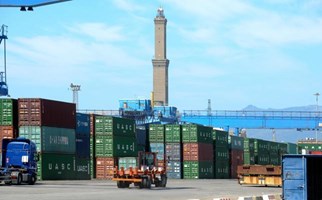Loading and reloading empty containers: measures to reduce transit of heavy goods vehicles
04/09/2018

One of the issues raised by road haulage companies in the
wake of the collapse of the Morandi bridge involves journeys along the
East-West axis, for lorries needing to unload empty containers in the internal storage
facilities and port terminals. It is an issue affecting at least 1,200 vehicles
a day, according to figures released by haulage company associations.
(A26 for Voltri-Pra’ and A7 for
Sampierdarena). It also enables import-export on Genoa to be balanced out, and reconnaissance
and identification of areas to be used for storage in each of the two basins,
according to the actual need for space. It also addresses the joint request from
haulage associations to extend the opening hours of the terminals and storage
facilities from 4 am to 10 pm, subject to permission from the Port Authority for the Western Ligurian Sea.
“The greatest risk which might occur, in
addition to gridlocking traffic,” states Alberto
Banchero, Chairman of Assagenti “involves
the lack of vehicles for transporting goods, which at present also have to make
up for the interruption of railway traffic heading for the
Sampierdarena basin. These are
estimated at around 2,300 containers a week, and they now have to undertake
longer journeys.” Together with the logistical measures, in the
coming days work will focus on bringing about a drastic reduction in waiting
times caused by inefficiencies of a practical and document-related nature. This
will allow vehicles to conclude their journeys as quickly as possible. “We need to work as if we have two
separate ports, Sampierdarena and Voltri-Pra’,”
Banchero explains. “Our
companies have been endeavouring to reorganise logistics over the last few
days, in order to find a new working approach. All sudden changes bring
problems which come to light with every passing hour, and for which solutions
must constantly be sought. The operators are working flat out to reduce even
the slightest inefficiency in the system; this work has now become top priority.
We expect everyone to do their bit, including government bodies. We have been
waiting for practical input from the Government for at least two weeks now;
instead, we heard nothing at all about the urgent measures which are needed.
This is not acceptable, given the nature of the situation we are being
subjected to.” As for other types of goods, one of the forms of
traffic at greatest risk are the special loads known as ‘project cargo’: “This is a type of goods,” Banchero
states, “whose load size makes
it necessary to send it via the A26 to reach the Sampierdarena basin for
embarkation. Given the current highway conditions, it is unlikely that this can
be maintained. The A7 is without doubt a section which poses problems for transportation
vehicles. The issue has been brought to light by some of our members, and we
will be addressing it in the relevant departments very soon.”
*Logistics for empty containers is one of the main elements
of both
import and export flows, an
increase in which depends on efficient management. In addition, it is one of
the main ways in which port activities impact on the city.
The “cycle” of empty
containers means that a load landing at the port has to be assigned to a haulier
who takes it to its destination. There, the container is emptied and
subsequently transported to the storage facility at Genoa. When the export of
the load is booked, the same container is taken from the storage by the
haulier, which first takes it to be filled, and then to the port where it is
embarked. The number of empty containers in the area, and which are available
to each maritime Company, is accordingly the result of forecasts made by the maritime
agencies on import and export flows. It varies considerably when traffic is
dominated by one flow more than the other. We can say there is a negative
balance when export is greater than import, and the local area needs a greater stock
of empty containers to take to be loaded. Instead, there is a positive balance
when imports are greater than exports and we need to “evacuate”, namely to
dispatch by ship, the empty containers to other ports. Generally speaking,
after August and the Christmas period, the balance is very positive owing to
the slowdown in exports caused by industry closing for the holidays. The
technical stock of each company in the local area (located in storage
facilities or port terminals) is twice that of export traffic volumes. This is
because a container being used for imports can be reused after about ten days, once
the logistical and document cycle has been completed. According to data
gathered by Assagenti, on average around 25 thousand empty containers are
stored on Genoese territory.